re模块
在python要想使用正则必须借助于模块,re就是其中之一
''' 基本操作方法 '''
import re
re.findall('正则表达式', '带匹配的文本') # 根据正则匹配除所有符合条件的数据
res = re.findall('a', 'eva chick jason')
print(res) # ['a', 'a'] 结果是一个列表(要么有元素,要么空列表)
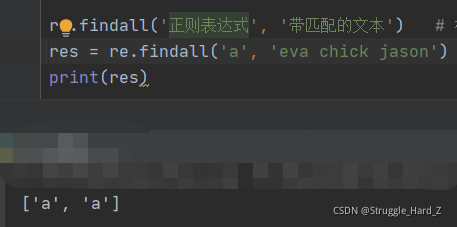
res = re.search('正则表达式', '带匹配的文本') # 根据正则匹配到一个符合条件的就结束
res = re.search('a', 'eva chick jason')
print(res) # 结果对象 <_sre.SRE_Match object; span=(2, 3), match='a'>
print(res.group()) # 正在的结果 a
""" 如果没有符合条件的数据 那么search返回None 并且使用group会直接报错"""
使用group不报错解决方案:
if res:
print(res.group())
else:
print('不好意思,没有找到')
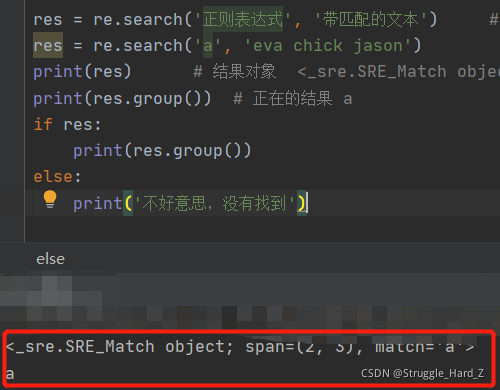
res = re.match('a', 'abcda') # 根据正则从头开始匹配(文本内容必须子啊开头匹配上)
print(res) # <_sre.SRE_Match object; span=(0, 1), match='a'>
print(res.group()) # a
""" 如果没有符合条件的数据,那么match返回None,而且使用group会直接报错"""
使用group不报错解决方案:
if res:
print(res.group())
else:
print('不好意思,没有找到')
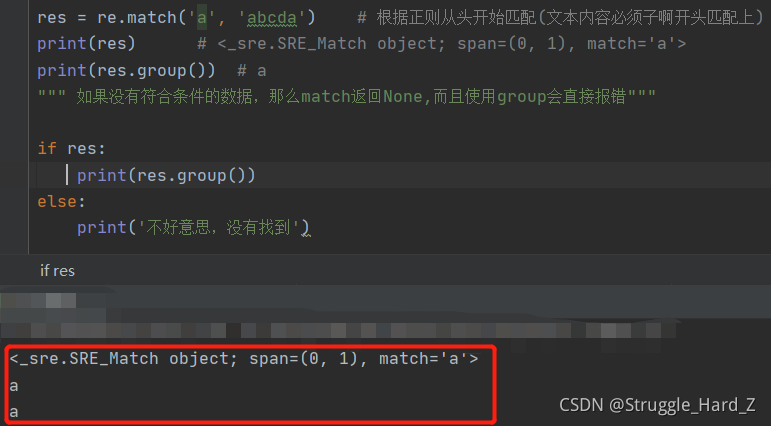
re模块其他方法
import re
# 先按'a'分割得到''和'bcd',在对''和'bcd'分别按'b'分割
res = re.split('[ab]', 'abcd')
print(res)
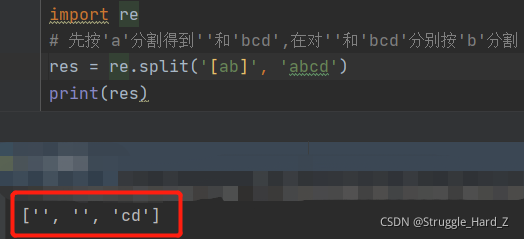
# 类似于字符串类型的replace方法
res = re.sub('\d', 'H', 'eva3chick4yuan4', 1) # 替换正则匹配到的内容
print(res) # evaHchick4yuan4
res1 = re.sub('\d', 'H', 'eva3chick4yuan4') # 不写默认替换所有
print(res1) # evaHchickHyuanH

# 返回元组,并提示替换了几处
res = re.subn('\d', 'H', 'eva3chick4yuan4', 1)
print(res) # ('evaHchick4yuan4', 1)
res = re.subn('\d', 'H', 'eva3chick4yuan4')
print(res) # ('evaHchickHyuanH', 3)
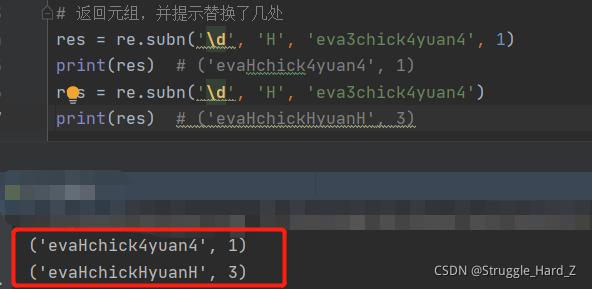
# 常用
regexp_obj = re.compile('\d+')
res = regexp_obj.search('absd213j1hjj213jk')
res1 = regexp_obj.match('absd213j1hjj213')
res2 = regexp_obj.findall('1213k1j2jhj21j3123hh')
print(res, res1, res2)

# 常用
res = re.finditer('\d+', 'ashdklah21h23kj12jk3klj112312121kl131')
print([i.group() for i in res])

res = re.search("1(\d{14})(\d{2}[0-9x])?$", ‘110105199812067023’)
print(res) # <_sre.SRE_Match object; span=(0, 18), match=‘110105199812067023’>
print(res.group()) # 110105199812067023
print(res.group(1)) # 10105199812067
print(res.group(2)) # 023
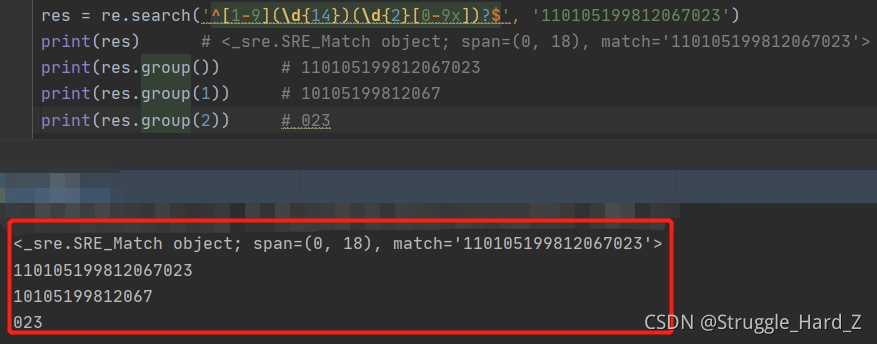
# findall针对分组优先展示 无名分组
res = re.findall("^[1-9]\d{14}(\d{2}[0-9x])?$", '110105199812067023')
print(res) # ['023']
# 取消分组优先展示 无名分组
res1 = re.findall("^[1-9](?:\d{14})(?:\d{2}[0-9x])?$", '110105199812067023')
print(res1) # ['110105199812067023']
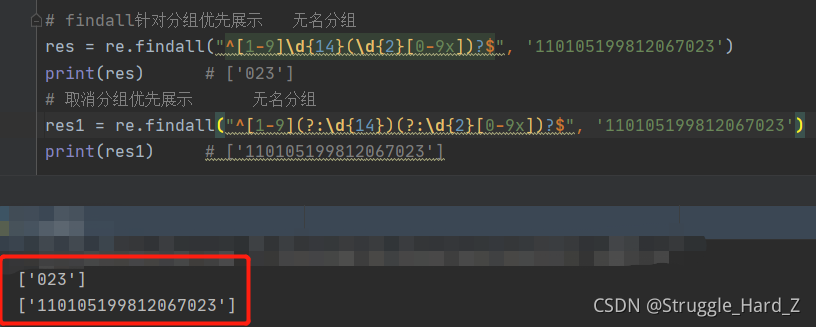
# 有名分组
res = re.search('^[1-9](?P<xx>\d{14})(?P<zz>\d{2}[0-9x])?$','110105199812067023')
print(res)
print(res.group())
print(res.group(1))
print(res.group('xx'))
print(res.group('zz'))

正则实战案例
import re
# 读取带匹配的数据
with open(r'a.txt', 'r', encoding='utf8') as f:
data = f.read()
# 利用正则匹配数据
# 分公司名称
title_list = re.findall('<h2>(.*?)</h2>', data)
# print(title_list)
# 分公司地址
address_list = re.findall("<p class='mapIco'>(.*?)</p>", data)
# print(address_list)
# 分公司邮箱
email_list = re.findall("<p class='mailIco'>(.*?)</p>", data)
# print(email_list)
# 分公司电话
phone_list = re.findall("<p class='telIco'>(.*?)</p>", data)
res = zip(title_list, address_list, email_list, phone_list)
for data_tuple in res:
print("""
公司名称:%s
公司地址:%s
公司邮箱:%s
公司电话:%s
""" % (data_tuple[0], data_tuple[1], data_tuple[2], data_tuple[3]))
collections模块
1.namedtuple(具名元组)
from collections import namedtuple
"""
namedtuple('名称',[名字1,名字2,...])
namedtuple('名称','名字1 名字2 ...')
"""
# point = namedtuple('坐标', ['x', 'y'])
# res = point(11, 22)
# print(res) # 坐标(x=11, y=22)
# print(res.x) # 11
# print(res.y) # 22
# point = namedtuple('坐标', 'x y z')
# res = point(11, 22, 33)
# print(res) # 坐标(x=11, y=22, z=33)
# print(res.x) # 11
# print(res.y) # 22
# print(res.z) # 33
# card = namedtuple('扑克', '花色 点数')
# card1 = card('?', 'A')
# card2 = card('?', 'K')
# print(card1)
# print(card1.花色)
# print(card1.点数)
2.队列
# 队列模块
import queue # 内置队列模块:FIFO
# 初始化队列
# q = queue.Queue()
# 往队列中添加元素
# q.put('first')
# q.put('second')
# q.put('third')
# 从队列中获取元素
# print(q.get())
# print(q.get())
# print(q.get())
# print(q.get()) # 值去没了就会原地等待
3.双端队列
from collections import deque
q = deque([11,22,33])
q.append(44) # 从右边添加
q.appendleft(55) # 从左边添加
print(q.pop()) # 从右边取值
print(q.popleft()) # 从做边取值
4.有序字典
normal_dict = dict([('name', 'jason'), ('pwd', 123), ('hobby', 'study')])
print(normal_dict)
{'hobby': 'study', 'pwd': 123, 'name': 'jason'}
from collections import OrderedDict
order_dict = OrderedDict([('name', 'jason'), ('pwd', 123), ('hobby', 'study')])
print(order_dict)
OrderedDict([('name', 'jason'), ('pwd', 123), ('hobby', 'study')])
order_dict['xxx'] = 111
order_dict
OrderedDict([('name', 'jason'), ('pwd', 123), ('hobby', 'study'), ('xxx', 111)])
normal_dict['yyy'] = 222
normal_dict
{'hobby': 'study', 'pwd': 123, 'yyy': 222, 'name': 'jason'}
5.默认值字典
from collections import defaultdict
values = [11, 22, 33,44,55,66,77,88,99,90]
my_dict = defaultdict(list)
for value in values:
if value>60:
my_dict['k1'].append(value)
else:
my_dict['k2'].append(value)
print(my_dict)
6.计数器
res = 'abcdeabcdabcaba'
# 统计字符串中每个元素出现的次数
# new_dict = {}
# for i in res:
# if i not in new_dict:
# new_dict[i] = 1
# else:
# new_dict[i] += 1
# print(new_dict)
from collections import Counter # 计数器
ret = Counter(res)
print(ret)
time模块
"""
时间三种表现形式
1.时间戳(秒数)
2.结构化时间(一般是给机器看的)
3.格式化时间(一般是给人看的)
三种时间是可以相互转换的!!!
"""
1.time.sleep() # 原地阻塞指定的秒数
2.time.time() # 获取时间戳时间(自1970-1-1 00:00)
import time
# 获取当前格式化的时间字符串
print(time.strftime('%Y-%m-%d')) # 2021-11-25
print(time.strftime('%Y-%m-%d %H:%M:%S')) # 2021-11-25 11:48:34
print(time.strftime('%Y-%m-%d %X')) # 2021-11-25 11:48:34
"""
更多时间相关符号 保存到容易查找的位置即可
"""
本地时区的struct_time(结构化的时间)
# print(time.localtime())
UTC时区的struct_time(结构化时间)
# time.struct_time(
# tm_year=2021,
# tm_mon=11,
# tm_mday=25,
# tm_hour=11,
# tm_min=51,
# tm_sec=25,
# tm_wday=3,
# tm_yday=329,
# tm_isdst=0)
# print(time.time())
print(time.gmtime(11111111111))
# print(time.localtime())

datetime模块
import datetime
# print(datetime.date.today()) # 2021-11-25
# print(datetime.datetime.today()) # 2021-11-25 12:15:11.969769
"""date年月日 datetime年月日时分秒 time时分秒(MySQL django后期可以)"""
# res = datetime.datetime.today()
# print(res.year) # 2021
# print(res.month) # 11
# print(res.day) # 25
# print(res.weekday()) # 获取星期(weekday星期是0-6) 0表示周一
# print(res.isoweekday()) # 获取星期(weekday星期是1-7) 1表示周一
"""时间差(timedelta)"""
# ctime = datetime.datetime.today()
# time_tel = datetime.timedelta(days=3)
# print(ctime) # 2021-11-25 12:20:48.570489
# print(ctime - time_tel) # 2021-11-22 12:21:06.712396
# print(ctime + time_tel) # 2021-11-28 12:21:06.712396
"""
日期对象 = 日期对象 +/- timedelta对象
timedelta对象 = 日期对象 +/- 日期对象
"""
# ret = ctime + time_tel
# print(ret - ctime) # 3 days, 0:00:00
# print(ctime - ret) # -3 days, 0:00:00
# 小练习 计算举例今年过生日还有多少天
# birthday = datetime.date(2000, 11, 11)
# now_date = datetime.date.today()
# days = birthday - now_date
# print('距离生日还有{}天'.format(days))
# UTC时间与我们的东八区时间差 八个小时
# print(datetime.datetime.now()) # 2021-11-25 12:25:33.579310
# print(datetime.datetime.utcnow()) # 2021-11-25 04:25:33.579310
1-9 ??